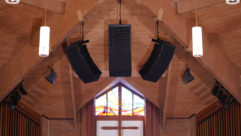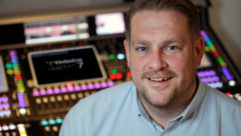
Allen & Heath ZED-14
May 1, 2008 12:00 PM,
By John McJunkin
Exceptional small-format analog mixer includes USB interface.

The intersection between pro audio equipment and computer technology is rapidly growing. There was a time when using pro audio gear and computers together was a dodgy affair, rife with struggles such as getting things integrated together in a way that was actually useful and worth pursuing. Now it’s getting easier every day. A great example of that is the recent development of mixers with integrated computer interfaces. Now this technology is moving beyond its humble beginnings, with greater degrees of sophistication. Allen & Heath has introduced its ZED series of mixers, which are small but professional and include a USB interface — facilitating connection with a computer. This interface does a lot more than just routing the mixer’s main outputs to the computer for recording. I spent time with an Allen & Heath ZED-14, which has six mono and four stereo inputs, and learned about some of these more sophisticated capacities.
The ZED-14 is compact, with a footprint of just more than 18″×15″. The reason why it’s not closer to a perfect square is that it has long-throw (100mm) faders, which I prefer hands down over the short-throw 60mm faders that commonly appear in smaller mixers such as this. The first six channels are monophonic, and starting from the bottom of the panel, you’ll find those faders — followed by a PFL button, a peak indicator LED, a mute button with an LED indicator, a pan knob, and then four auxiliary knobs. Auxiliaries 1 and 2 are permanently fixed as pre-fader, and auxiliaries 3 and 4 are permanently fixed as post-fader. A three-band +/-15dB EQ section appears above the auxiliaries, with a low shelf fixed at 80Hz, a high shelf at 12kHz, and a sweepable peak/notch mid band that varies between 120Hz and 4kHz. At the top of each channel strip is an input section with a 12dB/octave 100Hz HPF rumble filter, as well as a gain knob. The mixer’s mic pres are Allen & Heath’s two-stage DuoPre design, based on the manufacturer’s successful PA series. This design cleverly connects the line inputs directly to the second stage, reducing noise. Allen & Heath claims that this design distributes gain more evenly through the gain control knob, and I found this to be true — the gain curve doesn’t ramp up at the end of the knob throw as much as many other mic pres. Each mono input has an XLR mic input, 1/4in. balanced-line input,and a 1/4in. TRS send-receive insert jack.
The mixer’s four stereo inputs are nearly identical, with a couple of notable differences. For one, the mid-frequency EQ is missing, and there are switches to toggle auxiliaries 1 and 2 between dual-mono and linked-stereo operation. Above channel pairs 7/8, 9/10, and 11/12 are knobs that determine input levels from external stereo sources — namely two stereo RCA returns and the mixer’s USB stereo return. Above channel pair 13/14 are three buttons that determine how the USB signals are routed to and from the mixer (not to mention the actual USB connector). In the mixer’s main I/O section above the stereo channels are 1/4in. balanced input jacks in pairs. Above channel pairs 7/8 and 9/10 are two stereo RCA inputs, designated “ST RTN” and “2TRK RTN.” Above channel pairs 11/12 and 13/14 are stereo RCA outputs, designated “REC OUT” and “ALT OUT.” The mixer’s IEC power input and pushbutton power switch are the only features of the back panel.
Allen & Heath ZED-14
May 1, 2008 12:00 PM,
By John McJunkin
Exceptional small-format analog mixer includes USB interface.
The mixer’s master section starts with a stereo pair of faders, above which are found master knobs for auxiliaries 1 and 2, and an ALT OUT knob, intended to control output to monitor speakers. This output can be fed by the stereo bus or auxiliaries 1 and 2, and can be toggled between pre- and post-fader operation, in order to facilitate a control-room level independent of the main mix. Next up are the monitor selector switches, which determine where the headphone output and meters get their feed. The choices include auxiliaries 1 and 2 (or both as a stereo pair), the 2-track return, the USB return, or the main stereo bus. A headphone level knob and PFL active indicator LED appear next, followed by the mixer’s 12-segment two-channel LED VU meter and phantom-power switch and indicator LED. At the top of the master section are the mixer’s four auxiliary output jacks, main XLR outputs, TRS send-return main output insert jacks, a mono output jack, and headphones jacks — both 1/4in. and 1/8in. Frankly, this is a feature that simply floored me. I can’t tell you how many times I’ve run around searching for an adapter so I could plug in headphones. Having both sizes represented is simply brilliant. Finally, amidst all the aforementioned connectors is a bright-blue LED to indicate that the mixer is on.
When I hear the term “USB mixer,” my mental image is a mixer that can send its main outputs to a computer via USB. Maybe if it is a bit more sophisticated, it can send audio back from the computer to the mixer. The ZED series takes it all a step further. Audio can be sent from the mixer to the computer from any of four possible sources — auxiliary pairs 1 and 2 or 3 and 4 — or from the main L/R bus, in either a pre- or post-fader configuration. Audio can be routed from the computer to the mixer via USB and then fed either directly to the L/R bus or to stereo input 11/12, which facilitates EQ and auxiliary sends for that return audio. If a recording is being made with this console in a corporate setting, it is brilliant to be able to include audio from a computer so easily. In music-oriented applications, obviously audio can be recorded to a DAW on the computer (and the ZED series ships with Cakewalk Sonar 6 LE software, a remarkably powerful DAW/MIDI sequencer package). One application that I hadn’t considered before the ZED-14 manual pointed it out to me is the use of a computer as an effects device via USB. I have certainly used computers as outboard signal processors before, but the simple facilitation of this via the USB connection is brilliant.
The ZED-14 simply could not be any more straightforward in its operation. I unpacked it, plugged it in, and fed it some signals, and everything went very smoothly. The only unorthodox I/O issues surround the USB port, but after literally a minute or two of reading and trial and error, I had it completely figured out. The DuoPre mic pres are exceptionally quiet, and sound very good. The EQ is also quite good — with fixed frequencies, slopes, and the fixed Q of the sweepable mid band all very musical. I tested the 100Hz HPF with air conditioning, and found it very effective at rumble elimination. As is usually the case with Allen & Heath products, the mixer has a good, solid feel, and its controls move smoothly. In particular, the faders feel quite nice.
The Allen & Heath ZED-14 would be a great small-format analog mixer even if no USB interfacing were included, and with the flexible and practical integration of that function, this console is highly worthy of consideration. There are certainly other mixers out there with USB interfaces, but for a small mixer, the USB implementation is pretty sophisticated here. There are numerous great reasons to consider using a mixer with a USB interface, and if you plan on doing so, take a look at the Allen & Heath ZED-14.
John McJunkinis the principal of Avalon Podcasting in Chandler, Ariz. He has consulted in the development of studios and installations, and he provides high-quality podcast-production services.
Allen & Heath ZED-14
May 1, 2008 12:00 PM,
By John McJunkin
Exceptional small-format analog mixer includes USB interface.
PRODUCT SUMMARY
Company: Allen & Heath www.allen-heath.com
Product: ZED-14
Pros: Exceptional implementation of a USB interface.
Cons: None to speak of.
Applications: Live sound, recording, computer-oriented applications.
Price: $499
SPECIFICATIONS
Frequency response
Mic in: 20Hz to 20kHz (+0.5/-1dB)
Line in: 10Hz to 20kHz (+0.5/-1dB)
THD+N
Mic in: 0.004% (1kHz at 0dB)
Line in: 0.005% (1kHz at 0dB)
Headroom
Analog: 21dB (from nominal to 0Vu)
USB: 14dB (from nominal to 0Vu)
Sample rate: 32kHz, 44.1kHz, or 48kHz
Noise
L/R out: -88dBu (faders at 0)
Mic pre: -127dBu (at max gain)
Dimensions: 18.3″×15.1″×4.4″
Weight: 14.3lbs. (6.5kg)










